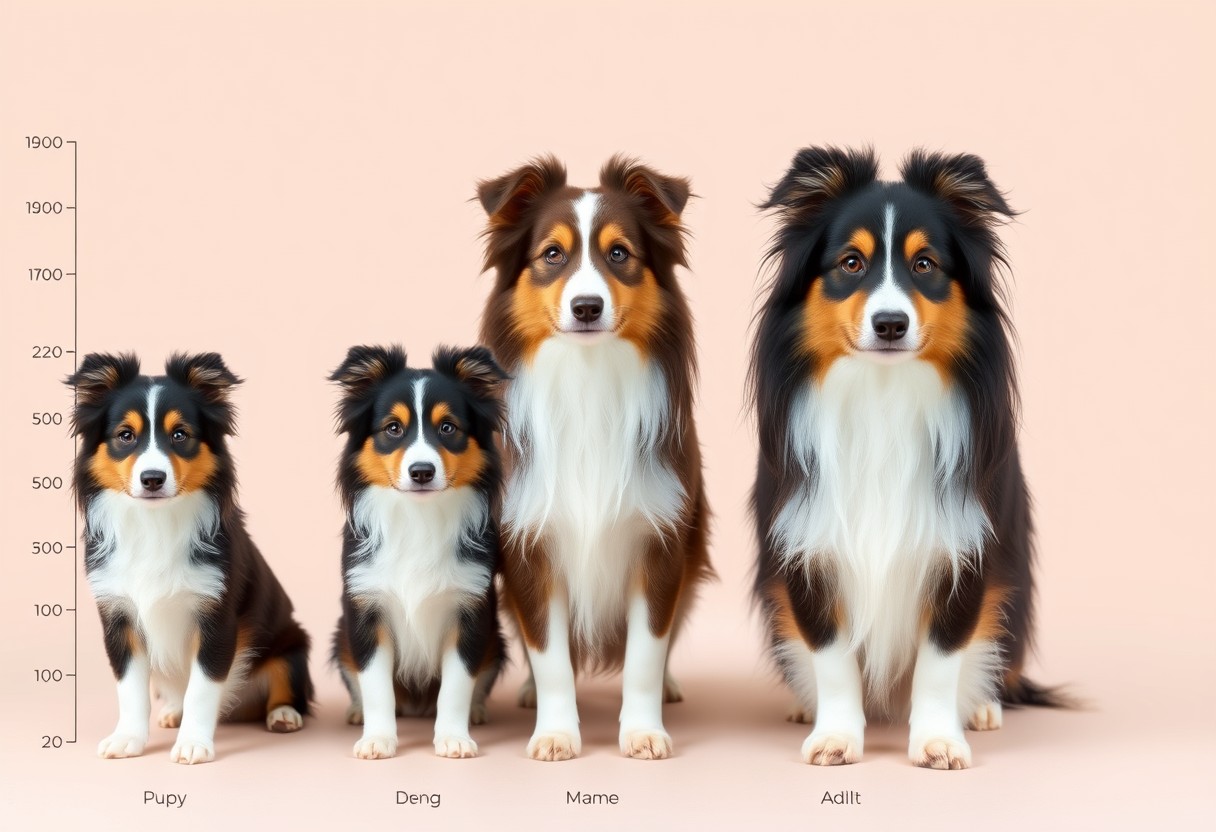Sheltie Growth Chart – 9 How Your Dog Develops Over Time

There’s a lot to look forward to as you watch your Sheltie grow! Understanding your dog’s growth stages is necessary for ensuring a happy and healthy life. From puppyhood to adulthood, each phase brings unique challenges and milestones that you’ll want to recognize. In this post, you’ll discover key insights on how your furry friend develops over time, so you can provide the best care during each important stage. Let’s dive in and help you prepare for the wonderful journey ahead with your beloved Sheltie!

Key Takeaways:
- Development Phases: Shelties experience distinct growth phases, including puppy, adolescent, and adult stages, each with unique developmental milestones.
- Size Expectations: Understanding a Sheltie’s growth chart helps in anticipating their adult size and ensuring they receive appropriate care and nutrition during their growth.
- Health Monitoring: Regularly tracking a Sheltie’s growth can aid in identifying potential health issues early on, allowing for timely veterinary intervention.

Understanding the Sheltie Breed
The Shetland Sheepdog, commonly known as the Sheltie, is a delightful and intelligent breed that captures the hearts of many dog lovers. With their keen senses and agility, these dogs were originally bred to herding sheep in the rugged terrain of the Shetland Islands. Shelties are known for their loyalty, playful personality, and strong bond with their families, making them fantastic companions for both individuals and families alike.
Origin and Characteristics
Breed history traces back to the late 19th century, where Shelties were developed from small working collies and various Scandinavian dogs. Their ancestry lends these dogs a strong work ethic and an affectionate temperament. Recognizable by their distinctive double coat, they come in a variety of colors, including sable, black, and blue merle. Shelties are highly intelligent and can be quite trainable, yet they also possess a tendency to be reserved around strangers.
Common Traits of Shelties
Originating as herding dogs, Shetland Sheepdogs are known for their high energy levels and intelligence. You will find that these dogs are incredibly loyal, often forming strong bonds with their families. Their playfulness makes them great companions for children, while their protective nature can make them wary of unfamiliar people. It’s necessary to provide consistent training and socialization to ensure your Sheltie develops into a well-rounded adult. Regular exercise not only keeps them physically healthy but also mentally stimulated.
Characteristics of Shelties often include a wonderful herding instinct and the ability to learn quickly. You’ll notice they love to be engaged, whether through obedience training, agility activities, or interactive play. Your Sheltie may also exhibit a tendency to bark, as they are naturally protective and alert. Keeping their coat well-groomed will help manage shedding and reveal the beauty of their silky fur, making them truly stand out in any setting.
Growth Stages of Shelties
You will witness remarkable changes in your Sheltie as they progress through different growth stages. Each phase plays a vital role in their physical and emotional development. Understanding these stages can help you provide the best care for your furry friend during their formative years.
Puppy Stage (0-6 Months)
Months 0 to 6 are crucial for your Sheltie’s growth, as they rapidly develop physically and socially. During this time, they will gain strength, coordination, and begin to learn key obedience skills. This is the perfect time for socialization to expose them to various environments, other pets, and people.
Adolescent Stage (6-12 Months)
Stage 6-12 months is the adolescent phase where your Sheltie begins to challenge boundaries and test their independence. You might notice some behavioral changes as they become more energetic and curious. Training and consistency are important during this time to guide their behavior and reinforce good habits. It’s crucial to keep up with socialization as well, as they may react with fear or aggression to new experiences if not properly exposed.
Months 6-12 can be a rollercoaster; your Sheltie will likely have bursts of energy and may flirt with rebellious behaviors. During this time, establishing clear leadership is vital to curb any undesirable habits. Be mindful of, patience is key as your Sheltie learns to navigate their changing emotions and impulses. Engaging them in plenty of physical activities and training sessions will foster a well-balanced, happy adult dog.

Health and Nutrition Tips
Many Sheltie owners wonder how they can optimize their dog’s health and nutritional needs. Ensuring your Sheltie receives proper care is imperative for a long and happy life. Here are some tips:
- Provide a balanced diet with high-quality dog food.
- Ensure your Sheltie gets adequate exercise.
- Monitor your dog for any health issues regularly.
- Schedule regular vet checkups to keep vaccinations up to date.
- Control portion sizes to maintain a healthy weight.
This approach will help keep your Sheltie flourishing and vibrant.
Essential Nutrients for Growth
The right balance of proteins, fats, carbohydrates, vitamins, and minerals is crucial for your Sheltie’s growth and overall well-being. Focus on a diet that includes high-quality protein sources and healthy fats to support muscle development and energy. Additionally, look for foods that are specifically formulated for puppies to ensure they get the necessary nutrients during their formative years.
Feeding Schedule Recommendations
An ideal feeding schedule for your Sheltie will play a significant role in their health. It’s recommended to feed your puppy three to four times a day to ensure they receive the right nutrients without overeating. As your dog grows into adulthood, you can transition to two meals a day to maintain a healthy metabolism and energy levels.
Feeding your Sheltie consistently will help establish a routine, which can lead to better digestion and overall behavior. Remember to keep a close eye on their body condition and adjust the portion sizes if you notice any weight gain or loss. Make sure to choose high-quality dog food that provides the necessary nutrients and avoid feeding them table scraps, as this can lead to serious health issues. Consistency and quality are paramount to your dog’s health.
Exercise Needs by Age
Once again, understanding your Sheltie’s exercise needs at different life stages is key to ensuring a happy, healthy dog. Puppies are naturally energetic and require frequent playtime to develop their social skills and coordination, while adult Shelties need regular exercise to maintain their physical health and emotional well-being. Keeping your dog active will help prevent behavioral issues and contribute to a long, fulfilling life together.
Puppies and Playfulness
With their boundless energy and curiosity, puppies thrive on playtime! Regular short bursts of energetic activity, like fetching toys or engaging in interactive games, will keep your little Sheltie stimulated while also fostering bonding. Socialization walks are equally important, helping your puppy learn about their environment and other pets.
Adults and Activity Levels
An adult Sheltie typically requires at least 60 minutes of exercise each day. This often includes walks, playtime, and mental stimulation activities, which can be achieved through training sessions or puzzle toys. Consistent exercise helps your dog maintain a healthy weight and promotes better behavior overall.
Levels of activity for your adult Sheltie can significantly affect their physical health and emotional stability. Ensuring that they have daily exercise not only helps to prevent obesity but also combats issues such as boredom and anxiety. Be mindful of, regular walks, agility training, and interactive play are important for keeping your Sheltie engaged and active. Over time, observe your dog’s energy levels and adjust their routine to meet their evolving needs, giving them the best quality of life possible!
Behavioral Development
Despite the adorable appearance and playful demeanor of your Sheltie, their behavioral development is a crucial aspect of their growth. As they transition from puppyhood to adulthood, you will notice significant changes in their behavior and temperament. From exploring their surroundings to establishing boundaries, each stage of development brings new challenges and rewards. Understanding these shifts will help you nurture a well-adjusted and happy companion.
Socialization during Growth
Behavioral development primarily hinges on socialization, which is vital during your Sheltie’s early life. Make sure to expose them to various people, animals, and environments early on. This exposure will help your pup cultivate a balanced personality and reduce anxiety around unfamiliar situations.
Training Tips for Each Phase
On your journey with your Sheltie, you’ll want to employ effective training tips for each developmental phase. Here are some suggestions to guide you:
- During the puppy phase, focus on *basic commands* like sit and stay.
- In adolescence, reinforce *leash training* to prevent pulling.
- As they mature, implement *advanced obedience training* to enhance their skills.
Any consistent practice helps solidify your bond and keeps your dog engaged.
Phase transitions can be exciting yet daunting. During the puppy phase, always prioritize positive reinforcement to foster a love for learning. In the adolescence stage, you may find your Sheltie testing their limits; stay patient and redirect their energy. As they reach maturity, introducing challenging tasks can greatly benefit their mental well-being. Consistency is key for all phases, and patience will yield the best results. Any loving approach will nurture your Sheltie’s growth.
Monitoring Your Sheltie’s Growth
All dog owners should regularly monitor their Sheltie’s growth to ensure they are developing properly. Keeping track of milestones in weight, height, and behavior helps you identify any potential health issues early on. Utilize a growth chart specifically designed for Shelties and note any changes in your dog’s appearance or energy levels. Bear in mind, your attentive observation is key to ensuring your furry friend remains happy and healthy!
Weight Tracking Guidelines
For effective weight tracking, you should weigh your Sheltie weekly during the first few months of its life. Record these weights to identify trends and ensure your pup is gaining the appropriate amount. Transition to bi-weekly weigh-ins as your dog grows. Use a reliable scale and consider factors such as diet, exercise, and overall health, ensuring you stay in touch with your veterinarian for tailored advice.
Signs of Healthy Development
Tracking your Sheltie’s growth involves observing signs of healthy development like consistent weight gain, increased energy levels, and normal bodily proportions. A well-nourished and well-exercised Sheltie will display a shiny coat, bright eyes, and a playful demeanor. Importantly, keep an eye out for sudden weight loss or lethargy, as these can indicate health issues. Regular check-ups with your vet ensure any concerns are addressed early and effectively.
Understanding your Sheltie’s growth patterns is vital to their well-being. Growth spurts can lead to increased appetite and activity, while fluctuations in weight or behavior may signal underlying health problems. A shiny coat and clear eyes are good indicators of a healthy Sheltie. Always make note of any unusual changes, as these could lead to serious issues requiring veterinary attention. Keeping a close watch on these signs will ensure your Sheltie thrives throughout its development.
Conclusion
On the whole, tracking your Sheltie’s growth can be an exciting journey as you witness their transformation from a playful puppy to a mature companion. Understanding the key milestones in your dog’s development will not only enhance your bond but also help you provide the best care tailored to their needs. Remember to celebrate each stage of their growth and cherish the moments you share together as they evolve into the loyal friend you’ve always wanted.
FAQ
Q: What is a Sheltie growth chart and how is it useful for dog owners?
A: A Sheltie growth chart is a visual representation that outlines the expected weight and height of Shetland Sheepdogs (Shelties) at various ages, from puppyhood to adulthood. It is useful for dog owners as it provides benchmarks against which they can measure their dog’s growth and development. By tracking their dog’s growth against the chart, owners can ensure their Sheltie is growing at a healthy rate and identify any potential health issues early on. This information can also assist in planning for nutrition and exercise needs specific to their dog’s lifecycle stage.
Q: At what age do Shelties reach their full height and weight?
A: Shelties typically reach their full height by around 12 months of age, but they may continue to fill out and gain weight until they are about 18 months to 2 years old. On average, male Shelties weigh between 35 to 45 pounds while females typically weigh between 25 to 35 pounds. By referencing a Sheltie growth chart, owners can compare their dog’s current measurements to the expected range for their age and ensure that they are on track to reach their expected adult size.
Q: What factors can influence the growth rate of a Sheltie puppy?
A: Several factors can influence the growth rate of a Sheltie puppy, including genetics, diet, exercise, and overall health. Genetics plays a crucial role, as puppies from larger parents may grow at a different rate than those from smaller parents. A balanced and nutritious diet is vital for healthy growth, with appropriate amounts of protein, fats, and carbohydrates tailored to their age and activity level. Additionally, regular exercise promotes muscle development and overall fitness. Health issues, whether congenital or acquired, can also affect growth rates, so regular veterinary checkups are vital to monitor their development.





